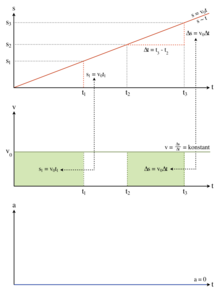Uniform movement
A uniform motion as a concept of physics (also uniform translation or uniform linear motion ) is a motion with constant speed and without change of direction. If the reference system in which the uniform movement is described is an inertial system , it follows from the principle of inertia that no external force acts on the moving object. The possibility that the body remains at rest can be understood as a uniform movement with zero speed.
Since the speed is a vector , constancy of the speed means that neither the amount of the speed nor the direction of movement changes. In order to be able to better distinguish the uniform motion from the uniform circular motion , in which only the amount of the speed is constant, it is also called "rectilinear uniform motion". The uniform movement is thus a special case of a uniformly accelerated movement with zero acceleration.
Without vector illustration
When a uniform motion is valid for the period covered distance , the value of: is constant, that is, at equal time intervals are equal distances traveled. So the following applies: The path is proportional to time:
is used because no absolute time is used here (e.g. 4 November 2:00 p.m.), but only the length of a period or a time difference, for example 10 minutes.
In this case , the distance covered during the time difference can be calculated by
Vector illustration
In vector terms, the following laws apply:
- Path-time law:
- Speed-time law:
The speed is the first derivative of the way in terms of time.
- (by definition)
- Acceleration-time law:
The acceleration is the second derivative of the path in terms of time.
Denote:
- = Position vector at the time
- = (constant) speed,
- = Acceleration and
- = Time.
When the equations are applied to movements that do not conform to the laws of uniform movements, the average speed is determined.
Web links
- Uniform movement with examples etc. at student level ( LEIFI )
Individual evidence
- ^ Paul Dobrinski, Gunter Krakau, Anselm Vogel: Physics for engineers . 12th edition. Vieweg + Teubner Verlag, Wiesbaden 2010, ISBN 978-3-8348-0580-5 , pp. 23 ( limited preview in Google Book Search [accessed December 29, 2016]).
- ↑ Alfred Böge: Vieweg manual mechanical engineering: Basics and applications of mechanical engineering . 18th edition. Vieweg + Teubner Verlag, Wiesbaden 2007, ISBN 978-3-8348-9092-4 , p. B13 ( limited preview in Google Book Search [accessed December 29, 2016]).
- ↑ Günter Simon, Jürgen Zeitler: Physics for technicians and technical professions: with 170 examples, 316 tasks with solutions and a collection of formulas . Specialist book publ. Leipzig in Carl-Hanser-Verlag, 2007, ISBN 978-3-446-41048-0 , p. 69 ( limited preview in Google Book Search [accessed December 29, 2016]).
- ^ Paul Dobrinski, Gunter Krakau, Anselm Vogel: Physics for engineers . 12th edition. Vieweg + Teubner Verlag, Wiesbaden 2010, ISBN 978-3-8348-0580-5 , pp. 36 ( limited preview in Google Book Search [accessed December 29, 2016]).
- ^ Online formula collection from Duden-Paetec, accessed on January 28, 2012 .













